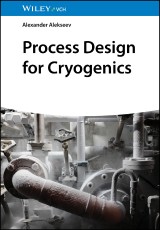Details

Process Design for Cryogenics
1. Aufl.
|
CHF 142.00 |
|
| Verlag: | Wiley-VCH (D) |
| Format: | |
| Veröffentl.: | 25.07.2024 |
| ISBN/EAN: | 9783527815609 |
| Sprache: | englisch |
| Anzahl Seiten: | 528 |
DRM-geschütztes eBook, Sie benötigen z.B. Adobe Digital Editions und eine Adobe ID zum Lesen.
Beschreibungen
<p><b>Up-to-date overview of the method for producing the main industrial gases</b> <p>This book covers process design for cryogenic processes like air separation, natural gas liquefaction, and hydrogen and helium liquefaction. It offers an overview of the basics of cryogenics and information on process design for modern industrial plants. Throughout, the book helps readers visualize the theories of thermodynamics related to cryogenics in practice. A central concept in the book is the connection between the theoretical world of process design and the real limitations given by available hardware components and systems. <p>Sample topics covered in <i>Process Design for Cryogenics</i> include: <ul><li>Cryogenic gases like nitrogen, oxygen, argon, neon, hydrogen, helium, and methane</li><li>Thermodynamics</li><li>Typical cryogenic refrigeration processes, including the classic Joule Thomson process, the contemporary mixed-gas Joule Thomson process, and expander-based processes like Brayton and Claude cycles</li><li>Helium and hydrogen liquefaction and air separation</li></ul> <p><i>Process Design for Cryogenics</i> is a comprehensive must-have resource for engineers and scientists working in academia and industry on cryogenic processes.
<p>Preface xix</p> <p>Acknowledgments xxi</p> <p>Symbols, Signs, and Abbreviations xxiii</p> <p><b>1 Introduction 1</b></p> <p>1.1 Historical Background 3</p> <p>1.2 Cryogenic Applications 5</p> <p>References 9</p> <p><b>2 Basics of Process Design 11</b></p> <p>2.1 Design Procedure 12</p> <p>2.2 Process Simulators and Fluid Properties 15</p> <p>2.3 Optimization 15</p> <p>2.4 Control Concept 17</p> <p>References 18</p> <p><b>3 Cryogenic Fluids 19</b></p> <p>3.1 Air 19</p> <p>3.2 Nitrogen 22</p> <p>3.3 Oxygen 23</p> <p>3.4 Argon 24</p> <p>3.5 Methane 25</p> <p>3.6 Neon 26</p> <p>3.7 Hydrogen 27</p> <p>3.8 Helium 31</p> <p>3.9 Temperature–Enthalpy Diagram 34</p> <p>3.10 Temperature–Entropy Diagram 36</p> <p>References 38</p> <p><b>4 Reversibility Concept 39</b></p> <p>4.1 Reversibility and Irreversibility 39</p> <p>4.1.1 Irreversibility 39</p> <p>4.1.2 Reversibility 40</p> <p>4.2 Carnot Engine 40</p> <p>4.3 Reversible Process as Benchmark 42</p> <p>4.4 Entropy 42</p> <p>4.5 Exergy Concept 45</p> <p>4.6 Application of Exergy Concept for Thermodynamic Analysis, Exergy Loss 49</p> <p><b>5 Unit Operations for Cryogenic Processes 51</b></p> <p>5.1 Isenthalpic Expansion 51</p> <p>5.2 Expansion in Expander 62</p> <p>5.3 Heat Exchanger 72</p> <p>5.4 Single Adiabatic Compression Stage 81</p> <p>5.5 Multi-Stage Compression, Isothermal Compression 86</p> <p>References 94</p> <p><b>6 Key Hardware Components 95</b></p> <p>6.1 Thermal Insulation/Coldbox 95</p> <p>6.2 Heat Exchanger 101</p> <p>6.3 Expanders 115</p> <p>6.4 Expansion Valve 136</p> <p>6.5 Compressors 136</p> <p>References 167</p> <p><b>7 Cryogenic Refrigeration 169</b></p> <p>7.1 Principle of Cryogenic Refrigeration 172</p> <p>7.2 Joule–Thomson Process (Nitrogen Joule–Thomson Process) 181</p> <p>7.3 Brayton Process 213</p> <p>7.4 Claude Process 236</p> <p>7.5 Mixed-Fluid Joule–Thomson Process 279</p> <p>7.6 Cryogenic Refrigeration Processes, Life Cycle 330</p> <p>References 331</p> <p><b>8 Liquefaction of Cryogenic Gases 333</b></p> <p>8.1 Thermodynamic Basics for Liquefaction 333</p> <p>8.2 Nitrogen Liquefaction 355</p> <p>8.3 Helium Liquefaction 374</p> <p>8.4 Natural Gas Liquefaction 400</p> <p>References 438</p> <p><b>9 Supplements 439</b></p> <p>9.1 Supplements for Cryogenic Refrigeration 439</p> <p>9.2 Supplements for Liquefaction 445</p> <p>References 487</p> <p>Index 489</p>
<p><i><b>Alexander Alekseev</b> is a senior innovation manager at the Linde Group (Germany). He studied at Moscow Power Engineering Institute (Russia) and completed his PhD at the Technical University of Dresden (Germany). He then worked at Stanford University (USA) as a guest scientist and at Messer Cryotherm (Germany), before joining the Linde Group in 2005. Since 2012 he is also a honorary Professor at the Technical University of Munich (Germany).</i>
<p><b>Up-to-date overview of the method for producing the main industrial gases</b> <p>This book covers process design for cryogenic processes like air separation, natural gas liquefaction, and hydrogen and helium liquefaction. It offers an overview of the basics of cryogenics and information on process design for modern industrial plants. Throughout, the book helps readers visualize the theories of thermodynamics related to cryogenics in practice. A central concept in the book is the connection between the theoretical world of process design and the real limitations given by available hardware components and systems. <p>Sample topics covered in <i>Process Design for Cryogenics</i> include: <ul><li>Cryogenic gases like nitrogen, oxygen, argon, neon, hydrogen, helium, and methane</li><li>Thermodynamics</li><li>Typical cryogenic refrigeration processes, including the classic Joule Thomson process, the contemporary mixed-gas Joule Thomson process, and expander-based processes like Brayton and Claude cycles</li><li>Helium and hydrogen liquefaction and air separation</li></ul> <p><i>Process Design for Cryogenics</i> is a comprehensive must-have resource for engineers and scientists working in academia and industry on cryogenic processes.
Diese Produkte könnten Sie auch interessieren:

Chemistry for the Protection of the Environment 4

von: Robert Mournighan, Marzenna R. Dudzinska, John Barich, Marjorie A. Gonzalez, Robin K. Black

CHF 236.00















